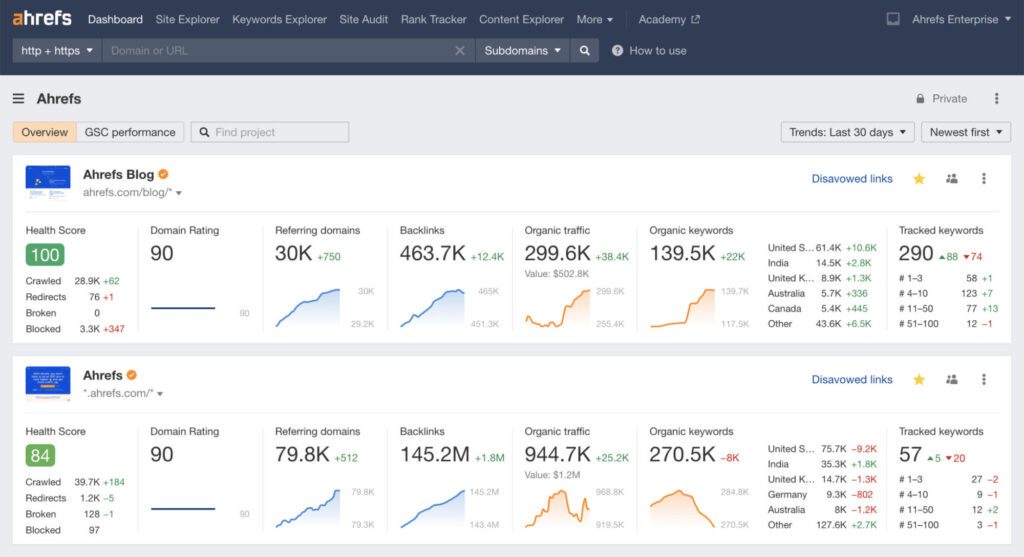Case Study
Working around limited
EDM stats
By Samantha Zaragoza | November 9, 2022
When client-provided statistics can’t answer their question on what’s wrong with email newsletter performances, we must rely on public resources like SEO tools to help them achieve their objectives.
Business Objectives:
• Lead Generation
• Sales Enablement
Verticals:
• Sales & Marketing
![]()
“The EDM statistics are looking bleak. How can we make the results better? We’re not sure what’s wrong.”
My heart sank after reading our client’s message. It’s that time of the year when we review the weekly email newsletters, aka EDMs, that we write for them. We compare new EDM statistics to previous quarters’ and even with last year’s performances. Included in the newsletters are link-outs to blogs found on their site, also written by With Content. Starting the review with bad news isn’t obviously ideal, but it only means we need to keep investigating.
First, we need to take stock of what we have. Our prime reference for measuring newsletter performance is client-provided EDM statistics. This report:
- Only shows unique open rates and click-to-open rates
- Doesn’t furnish us with each content piece’s traffic performances
- Doesn’t provide a view of a recipient’s journey after receiving the newsletter: what they click, where they land, and if they were successfully converted into leads
With all of these vital data lacking, we’re confronted with how best to answer “what’s wrong?” We understand where our client is coming from, and we want to give them the best answers possible. Since we know we can’t rely on their in-house reports, we have to look elsewhere.
Thankfully, with available tools online, we can dig out a response to that question. For this problem, we turn to our SEO tool Ahrefs. This case study shows how online SEO tools like Ahrefs can support content review hypotheses and suggestions with additional data that’s available to the public.
What are EDMs and EDM statistics?
 Image by our-team on Freepik
Image by our-team on Freepik
EDM, or electronic direct mail, is a digital marketing strategy where companies use emails to send content or promote products and services. It’s deemed essential to marketing campaigns because it can reach a big audience. Considering the target readers have subscribed to your newsletters, they’re a captured market that can quickly turn into prospective customers. It can also keep current clients loyal through constant and meaningful communication.
As a marketing tool, EDM campaigns should help move audiences or leads down the marketing funnel. In a nutshell, EDMs are most effective when:
- It speaks to different audiences according to the funnel stages they are in. For example, separating emails for potential customers versus long-time clients.
- It uses language that appeals to these different groups. For existing customers, addressing them by their names may encourage clicks compared to a generalised subject line.
- It is useful to the specific reader, and it has a main purpose. What can they get out of opening your email? And what do you want them to do after receiving the email? Here you can include deals and special content. When creating useful content, see how else you can extract information from your audience. Say you have an industry e-book they’ll need for strategic planning, and they decide to forward that email to colleagues, it should be gated so that you can collect new potential customers’ email addresses and basic data.
- It maximises an email marketing automation platform (like MailChimp, Hubspot, or Pardot) for campaign automation and data analysis. For example, a platform can create an automated decision tree like this one. The more data you feed the platform, the more insights it can give apart from the usual open rates and click rates–like the best days and times to send emails, where the recipients read their emails, and more.
All these are planned out before diving into A/B testing, wherein you use data insights to formulate and test different templates, subject lines, preheaders, body length, and other EDM components. This trial-and-error approach refines your campaign and gives you the most effective options that increase clicks and conversions.
From here, EDM statistics are measured after a campaign, and should present these rates:
Basic:
Open rates
The number of subscribers (out of the total subscribers emailed) who opened the email
Click-through rates
The percentage of clicks that opened at least one link in the email body out of the total number of times the message was delivered
Click-to-open rates
The number of unique clicks as a percentage from unique opens
Unsubscribe rates
The number of recipients (out of the total subscribers emailed) who unsubscribe to the email
Other helpful rates:
Complaint rates
The percentage of recipients (out of the total subscribers emailed) who mark the email as spam
Conversion rates
The number of subscribers (out of the total subscribers emailed) who complete an action after receiving the email
Forward/share rates
The number of subscribers (out of the total subscribers emailed) who forwarded or shared the email
List growth rates
The percentage of new subscribers added to your list/s
Client’s objectives
The emails we craft for our client do not particularly follow a specific campaign. The purpose of these newsletters is to increase brand awareness and improve website traffic. The metrics they want to measure are open rates and click rates.
The issues hindering us from meeting objectives
Because the client’s company operates in silos, retrieving information from other departments is a tedious if not impossible task for their content marketing team. For example, the sales department can be instrumental in providing client data, along with pointing out how customers interact with their products and services. However, the sales and content marketing teams do not communicate with each other.
This makes it difficult to craft a solid EDM strategy or campaign, resulting in inadequate or superficial EDM statistics. Currently, the team isn’t allowed to collect and access audience information, which disables gated content, grouping audiences, and even personalising emails.
We understand these hindrances and aim to push the needle through long-term content reviews. This way, we can use external SEO tools like Ahrefs to observe audience behaviour based on website traffic and keyword usage.
Our approach
The operative word here is “long-term.” Through comparing historical data, we can hypothesise and paint a picture of the audience and use that to test our solutions.

With Ahrefs, we can help meet the client’s objectives and substantiate open rates and click rates. We’ll be able to support questions such as:
- Why are the rates high or low?
- How are the EDM themes and topics received?
- Where else are the audiences receiving the same information?
We begin with analysing the competition’s performances by checking their trending topics and keywords, referring domains, and content traffic. We compare this with the client’s metrics. We then review top trending articles and what about these hook the audience to read the content.
We also look at other websites competing for the same keywords, so we can determine the topics that attract most readers.
After we define and plot changes on audience characteristics and their pain points, we work with the client through A/B testing. As we conduct trial and error, we are able to refine our approach and pinpoint changes, even small dips and rises, in comparative data calculations.
We also help educate our clients with content strategies that can support EDM campaigns. For example, we’ll need to refine newsletters to have:
- A specific purpose that we can track. For example, is it downloading useful content or availing of a promo?
- Separate audiences. Despite the lack in customer profiles, we can try determining and separating industries and countries (since the EDMs are sent to multiple countries).
- A content roadmap for each group or channel. We will need the client’s help in defining the audience with precise questions so that a content roadmap can guide topic generation, which should answer perceived customer questions.
- More robust A/B testing. Each EDM should focus on split testing specific components over long periods of time to have a better understanding of what works for the different recipient groups.
These are the things we can do on the content front without troubling the client to provide data, which they have issues pulling out from their company.
Conclusion: Working with time
Although it takes time, our content review strategy should be able to push the needle and find new content directions and solutions that resonate with the client’s audience.
Content strategists like us here at With Content must clearly communicate this to clients, explaining that tailor-fit strategies will take time to bear fruit. Establishing this challenge while fostering a healthy and collaborative working relationship has helped us create a deep understanding of their (and their customers’) needs, and explore new frontiers in content creation.


